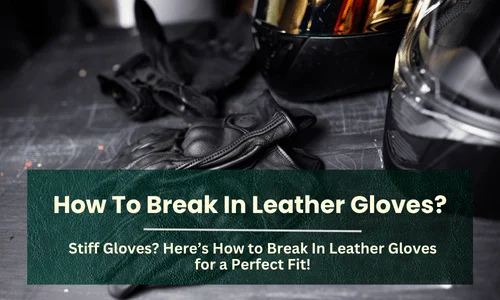There’s nothing quite like the feel of a good pair of leather gloves, but those first few wears can be rough. If you’ve ever struggled to flex your fingers or felt like your gloves were working against your hands, you’re not alone. I’ve helped many folks break in leather gloves over the years, and it’s always the same story: stiff at first, perfect with the right care. With a little patience and the right techniques, you can speed up the break-in period and make your gloves fit like they were made just for you.

Why Breaking in Leather Gloves Is So Important?
New leather gloves feel tight for a reason. The leather hasn’t yet adapted to your hands, so movements feel restricted and sometimes even uncomfortable. But leather is a natural material, with regular wear and some gentle stretching, it begins to mold to your unique shape. Breaking them in the right way ensures you don’t damage the leather while still getting the fit and flexibility you need. For everyday wear, riding, or work, well-broken-in gloves offer better control and protect your hands more effectively.
Read More: How To Clean Leather Horse Riding Gloves?
“Leather is meant to breathe and respond to your body over time,” says Mark Ellery, a leather goods technician with over two decades of experience. “But how you treat it early on makes all the difference in long-term comfort.”
The Tools That Help Soften Your Gloves Safely
To break in leather gloves without causing damage, stick to basic, trusted tools. A good leather conditioner keeps the material soft and prevents cracking. Lukewarm water helps relax the fibers if you need to do some light stretching. I also recommend using soft cloth, cotton, or newspaper to stuff the gloves overnight. And while heat can be helpful in moderation, it’s easy to overdo it, so always proceed with caution.
Step-by-Step: How Do I Break In Leather Gloves?
Step 1: Just Wear Them Often
There’s no substitute for regular use. Start wearing your gloves around the house or while running errands. Every movement helps the leather adjust to your hand shape. Curl your fingers, clench and release your fists, the more natural motion, the better. After a few days of consistent wear, you’ll start to feel the difference.
Step 2: Condition the Leather
Apply a small amount of leather conditioner to a soft cloth, then rub it gently into the gloves. Focus on tight areas like the fingers and knuckles. Let the conditioner absorb fully before wearing the gloves again. This step keeps the leather hydrated and more flexible, helping it stretch without cracking.
Step 3: Stretch Gently Where Needed
If a particular spot feels too tight, like the thumb joint or base of the fingers, try gently stretching that section with your hands. You can also dampen the gloves very slightly with lukewarm water beforehand, but never soak them. The leather should feel warm and pliable, not wet and saggy.
Step 4: Stuff Overnight for Extra Give
Stuffing your gloves with fabric or paper is an old trick that works well. Be sure to fill out each finger and the palm area. Leave them like this overnight, and by morning the leather will be slightly expanded, giving you a more natural fit.
Step 5: Use Mild Heat Carefully
Warmth helps soften leather, but too much heat dries it out fast. If needed, put the gloves on and wave a hairdryer at them on low for 20-30 seconds at a time. Keep moving the dryer and never hold it too close. You want the gloves warm, not hot.
“Heat should never be your first option,” cautions Jenna Cruz, a leather repair expert at GloveCraft Studio. “Use it as a last resort, and always follow up with conditioning.”
Matching Your Break-In Method to the Glove Type
Not all leather gloves are created equal. Thicker work gloves usually respond well to conditioning and daily wear. Thin dress gloves, on the other hand, need extra care during stretching to avoid damage. Gloves with inner linings, like wool or fleece, will take longer to conform but still benefit from all the same steps. Just be patient and let the process unfold gradually.
Takeaways: Better Fit, Better Feel
Breaking in leather gloves takes time, but it’s worth it. When done right, they become an extension of your hands, comfortable, flexible, and perfectly fitted. Regular wear, gentle conditioning, careful stretching, and smart use of heat all play a role in shaping your gloves without damaging them. Don’t rush it. Give the leather time to respond to you, and you’ll end up with a pair that feels like second skin in every season.
- How to Wear an Oversized Leather Jacket? Style Tips for a Casual Look - August 6, 2025
- How to Fold a Leather Jacket? - August 5, 2025
- How Should a Leather Jacket Fit a Woman? - August 1, 2025



